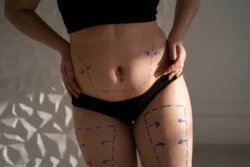Blepharoplasty, also known as eyelid surgery, is a functional and cosmetic procedure. It can be used to the lower, upper, or both eyelids to treat muscular laxity, extra fat, and sagging skin. Blepharoplasty, sometimes referred to as eyelid surgery, provides a younger, more refreshed appearance. We will discuss the definition of blepharoplasty, the advantages of eyelid surgery, and potential candidates for the treatment in this blog.
What is Blepharoplasty?
Blepharoplasty is a surgical technique for aging related changes around the eyes. In some cases, it is performed to correct vision obstruction caused by excess skin. Additionally, it enhances a more youthful and alert appearance.
Types of Blepharoplasty
1. Upper Eyelid Blepharoplasty
The upper eyelids drooping skin is the focus of the surgery. It can be performed for the eyesight obstruction brought on by extra skin and to provide the appearance of more youth and alertness.
2. Lower Eyelid Blepharoplasty
The purpose of this kind of surgery is to reduce wrinkles and bags beneath the eyes by removing extra skin and fat from the lower eyelids.
3. Double Eyelid Blepharoplasty
Double eyelid blepharoplasty, also known as Asian blepharoplasty. Those who have monolids (one smooth eyelid without a fold) will have a wrinkle in their upper eyelid after double eyelid surgery.
How Blepharoplasty Works:
1. Consultation
It is crucial that you consult with an experienced plastic surgeon before undergoing blepharoplasty. During the consultation, the surgeon discusses expectations, looks at the eyelids, and analyzes the patient’s medical history.
2. The use of anesthesia
Blepharoplasty is often carried out under either general anesthesia or local anesthetic with anesthesia, depending on the complexity of the procedure.
3. Position of incision
For upper eyelid surgery, incision is carefully placed along the eyelid’s natural fold.
In lower eyelid surgery, the incision is made inside the eyelid (transconjunctival technique) or slightly below the lower lash line to reduce apparent scars.
4. Removal and repositioning
A natural-looking outcome can be accomplished by carefully removing or repositioning excess skin, fat, and muscle.
5. Healing the cuts
Thin stitches are used to close the incisions; the stitches could break down or come out after a few days.
Recovery and Aftercare
Patients may have minor discomfort, bruising, and swelling after surgery, but these side effects usually go away in a week or two.
- During the initial week, bruising and swelling are common.
- Meanwhile, mild discomfort can be managed with pain medication.
- After 5-7 days non-dissolvable stitches are removed.
- For at least two weeks, avoid physical activities.
- Over the few weeks or months, the final results become visible.
- Additionally, to protect yourself from the sun, wear sunglasses.
Potential Risks and Problems
Blepharoplasty has risks, just like any other surgical surgery. These risks include:
- Initially, temporary discomfort or dry eyes
- However, there is a risk of bleeding or infection
- Additionally, temporary light sensitivity or vision problems
- In rare case, there might be difficulty in closing eyes (rare but possible)
- Furthermore, temporary swelling and bruising might be occurring.
Conclusion:
Blepharoplasty is an effective procedure for improving eye appearance and maintaining a young appearance. The surgery provides long-lasting effects with little recovery time, whether it is performed for useful or cosmetic purposes. If you are considering eyelid surgery, consult with a board-certified plastic surgeon to determine if you are a suitable candidate and to discuss your goals and expectations. Please visit Aestheticure for more information.Our best expertise and experienced surgeons will provide you with the best treatment and proper care.
For more information or to schedule a consultation, feel free to Contact Us!







